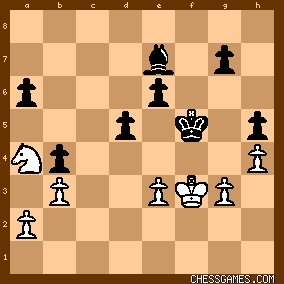KEG: Post IV
After 33. RxR, Schlechter was in control and polished off the game nicely: 33... Rc2!
This move completely paralyzes the White forces, allowing the Black King to pick off the undefended pawn on e5 at his leisure. The position is worth another diagram: 
click for larger view34. Kf1
Billecard's only chance of making even a semblance of a fight here was to play 34. e4! This would u leash his Rook. The game would almost certainly still be lost (e.g., 34...dxe4 35. Re1 Kf7 36. Rxe4 Rc1+ 37. Kf2 Ra1) but it was better than just sitting pat and watching Schlechter wipe him out. 34... Kf7
34...h5 restraining the White g-pawn was also good. 35. Re1
Billecard should certainly have tried 35. e4. This move was no longer as good as on his 34th turn, but Billecard's ostrich-like plan of sticking his head in the sand and hoping somehow for salvation made little sense. Alternatively, he might have considered 35. Rd4 35... Kg6
36. Re2?
Now the game was gone for certain. Pushing the e-pawn, belated as the idea now was, was still Billecard's best idea. 36... Rc1+
36...RxR would also have won.
37. Re1 RxR+
38. KxR
This left:

click for larger viewBillecard's position was clearly hopeless. His Knight remained a pathetic spectacle, and his pawns were weak. But Billecard played on. 38... Kf5
39. Ke2 Kxe5
Perhaps even better was 39...h5 to prevent 40. g4. But Schlechter's move was more than adequate. 40. b3
It must have been tempting for Billecard to try to get his Knight back into the game, but to have any chance to resist even for a short while he had to try 40. h5 or 40. g4. 40... Kf5!
The game is won anyway, but it is wonderful to see Schlechter's technique in action. With this move, he eliminates any prospect for White on the King-side. 41. Kf3 h5!
Further King-side domination. A diagram here tells the tale: 
click for larger viewThe rest was easy for Schlechter:
42. Nb2 e5
The pawn march begins!
43. Nd1
Finding a new square on which to bury his sickly Knight. 43... e4
Crushing.
44. Kg2 Bc5
0-1
This win brought Schlechter into a three way tie for second at 4-1 with Pillsbury and Marco just a half-point behind Maroczy. | 




